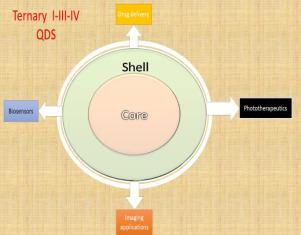Nano-Structures & Nano-Objects Pub Date : 2020-09-08 , DOI: 10.1016/j.nanoso.2020.100568 Olanrewaju A. Aladesuyi , Oluwatobi S. Oluwafemi

|
Semiconductor nanoparticles also known as quantum dots (QDs) have continued to receive more attention from researchers due to their unique optical, magnetic and photo physical properties which made them useful as biomedical materials, solar cells, catalyst etc. However, ternary I–III–VI QDs have shown to be a safer alternative to the binary II–VI or IV–VI QDs due to the absent of heavy toxic elements such as Cd and Pb. Cancer management and therapy in Africa has been bedevilled by a lot of challenges such as inaccurate diagnosis and ineffective therapeutic methods. Therefore, the need to develop an appropriate approach for cancer detection and treatment is of paramount importance. Tunable optical properties and absorption in the near infra-red region of the ternary QDs makes them useful as fluorescent probes in cancer detection and treatment. They have the ability to detect specific cancer cells including those that are not easily detected by modern imaging technique. Also, properties such as non-bleaching, stability, water solubility etc. made them a desirable fluorophore when compared to conventional dyes. Most cancer drugs suffer from inherent shortcomings such as limited absorption, insolubility and aggregation. However, these shortcomings can be overcome when these drugs are applied in form of conjugated systems. The use of QDs as conjugates has revolutionise the treatment of cancer in the 21st century. This review provides information about the synthesis strategies, optical properties, hydrophilization and bioconjugation of ternary I–III–VI QDs. Furthermore, we described the various biomedical applications in biosensors, bioimaging, drug delivery and phototherapeutic techniques. Finally, we looked at the challenges and future perspective of these QDs in cancer management.
中文翻译:

三元量子点的合成策略及其在癌症治疗中的应用
半导体纳米粒子,也称为量子点(QDs),由于其独特的光学,磁性和光物理性质而继续受到研究人员的关注,这使其可用作生物医学材料,太阳能电池,催化剂等。然而,三元I–III–由于不含重毒性元素(例如Cd和Pb),VI QD已证明是二元II-VI或IV-VI QD的更安全替代品。非洲的癌症管理和治疗受到许多挑战的困扰,例如错误的诊断和无效的治疗方法。因此,开发用于癌症检测和治疗的适当方法的需求至关重要。三元量子点的近红外区域具有可调节的光学特性和吸收特性,使其在癌症检测和治疗中可用作荧光探针。它们具有检测特定癌细胞的能力,包括那些通过现代成像技术不易检测到的癌细胞。而且,与常规染料相比,诸如非漂白,稳定性,水溶性等性质使它们成为理想的荧光团。大多数抗癌药物具有固有的缺点,例如吸收受限,不溶性和聚集性。但是,当这些药物以共轭体系形式使用时,可以克服这些缺点。QDs作为缀合物的使用在21世纪彻底改变了癌症的治疗方法。这篇综述提供了有关三元I–III–VI QD的合成策略,光学性质,亲水化和生物共轭的信息。此外,我们描述了生物传感器,生物成像,药物输送和光疗技术中的各种生物医学应用。









































 京公网安备 11010802027423号
京公网安备 11010802027423号